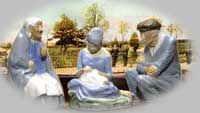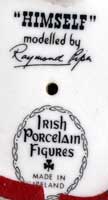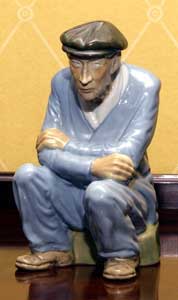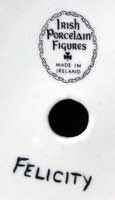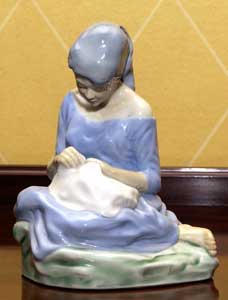|
Wade Irish Song Figures Article written by Dr. John Wright
|
|||
|
|
These eleven figures, varying in height from 6” to 9”, were produced by Wade in Portadown between 1962 and 1986. Their names, derived from well-known characters in Irish songs, and their official Wade reference numbers, are as follows:
|
|
|
|
These figures were cast using liquid clay or slip, as it was technically known, and were kiln fired twice. The first firing was at a temperature of 1250oC. The double process was needed in order to ‘fix’ particular colours and ensure the sharpness of the under glaze back stamp. They were certainly the best and most expensive figures made by Wade Ireland. In production, on and off, for fourteen years they were not a particularly strong seller at the time but they are now eagerly sought by collectors who appreciate the quality of these prestige figures. All of the series were re-issued in the 1990’s by Seagoe Ceramics Ltd, a subsidiary of Beauford plc, who had taken over the old Wade premises in Watson Street prior to moving to a new factory on the outskirts of the town. These later figures, though produced using the original moulds, differed somewhat from the originals. They were generally painted in darker tones. The differences were more obvious in some figures than in others. For example, the older version of Mother MacCree had a light blue bottom on her skirt; in the Seagoe version it was grey. The top of Eileen Oge’s dress was blue/grey but this became much darker grey in the later figure. Widda Cafferty’s blouse was grey/blue in the earlier figure but almost chocolate brown in the Seagoe version. To complicate matters slightly, the author has recently seen a 1970’s Widda Cafferty with a very dark blouse, differing markedly from other authentic versions of the figure produced around the same time. The collector need not be confused as the older figures were clearly marked, Irish Porcelain, Made in Ireland and carried the name of the figure and its modeller. All of the 90’s figures have a back stamp including the words ‘Seagoe Ceramics’. |
|||
| The origins of Dan Murphy, Mother MacCree and Eileen Oge are very interesting. In 1961, Iris Carryer commissioned local Belfast artist, Raymond Piper1, to model three figures. He based Dan Murphy on a real character he met in a Ballyaughlis pub near Belfast. His name was Harry McMullen, then aged about 70. Harry was a legend in his own lifetime because he was reputed to be the greatest teller of tall stories in Ireland. He was so adept at ‘spinning yarns’ that he was favourably compared to the celebrated Baron Munchausen whose incredible tales are known the world over. Apparently, his expertise was so great and his eloquence so convincing that his listeners were never quite sure that he was not telling the truth. In actual fact, when Piper’s figure was first marketed by Wade in 1962, he was called colloquially ‘Himself’. A short time later ‘Himself’ became part of the Irish Song series and was re-christened, Dan Murphy. |
"Himself" or "Dan Murphy"
|
||
|
"Herself" or "Mother MacCree"
|
Mother MacCree’s origin was similarly fascinating. This time Piper’s model for the figure was an old lady he knew well, called Mary Kelly. Mary lived rough for most of her days, though in later years she was a resident of a Catholic sanctuary for homeless women on the Falls Road in Belfast. She was born in Armagh City, in the area known lyrically as ‘Dobbin’s Flowery Vale’, but spent most of her adult life travelling the countryside. Mary was certainly a ‘larger than life’ character, if that is the proper phrase, considering she was about 4’- 6” tall. When Piper visited her to make preparatory sketches for his clay model her first question to him was “Are you married?” When he replied in the negative she said, “I’ll wait on you.” At this time Mary was 87 years of age! Piper’s figure was originally called ‘Herself’, though this was later changed to Mother MacCree. | ||
| Eileen Oge, perhaps the most graceful of all the Irish Song Figures, was modelled on Felicity Carryer (now Graham), the daughter of Iris Wade and Major Straker Carryer. Unlike the originals of the previous figures, Felicity is very much alive. At the risk of embarrassing her, she was renowned in the late 50’s as one of the most beautiful young ladies about Portadown. Felicity remembers, vividly, sitting for Raymond while he made his clay model. At that time, she had short hair but he gave her long hair, which pleased her greatly. This figure was originally entitled ‘Felicity’ but was later changed to Eileen Oge, ‘the pride of Petravore’ in the famous Percy French song. |
"Felicity" or "Eileen Oge"
|
||
|
It is not generally known that the three figures designed by Raymond Piper were never meant to be produced in the grey/blue colouring which characterised them. It was Piper’s wish that they should have either a clear glaze over an unpainted body or else salt-glazed in the manner of early 18th century Staffordshire figures. However, Sir George Wade decided otherwise. The resulting friction between Wade and Piper was almost certainly the reason why William Harper was commissioned to design the other eight figures in the series. Though Piper thought, with some justification, that Sir George was being ‘bloody–minded’ there is another dimension to the argument. When figures emerge from a kiln, a substantial number will have minor blemishes. In the ordinary run of events, this is of little importance as, when painted and glazed, these tiny imperfections are not seen. If, on the other hand, a translucent glaze is applied to biscuit figures, any firing faults would remain visible making them impossible to sell. In addition, the production of salt-glazed figures would have necessitated re-setting kiln temperatures, thus interfering with the production of other ranges of Wade porcelain. So there were economic and operational reasons for the decision taken by the company. Bill, a sprightly 80 year old, remembers vividly doing the preparatory sketches for the figures. He took his inspiration from the words of the songs though he admits that two of the figures were modelled from drawings produced by Wade (Burslem). All of Harper’s creations are appealing, especially the Widda Cafferty, the Bard of Armagh and Phil the Flutter. The reputation and creative genius of both modellers, Piper and Harper, together with the skill and industry of the workers in Wade (Portadown) have made the Irish Song Figures eagerly sought after by discerning Wade collectors everywhere. |
|||
|
John R Wright Copyright 2003
|
1, Raymond Piper is a well-known Ulster artist. In 1992 he was awarded the Gold Medal for portraiture by the Royal Ulster Academy. A year later he received the equally prestigious James Kennedy Award from the Royal Hibernian Academy. His paintings of Irish orchids have brought him international fame. He is an illustrator and co-author of books on Ireland. | ||
